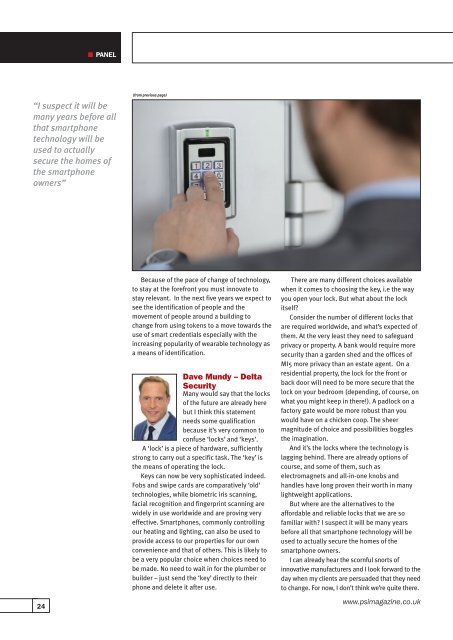PSIJuly2018
Create successful ePaper yourself
Turn your PDF publications into a flip-book with our unique Google optimized e-Paper software.
PANEL<br />
“I suspect it will be<br />
many years before all<br />
that smartphone<br />
technology will be<br />
used to actually<br />
secure the homes of<br />
the smartphone<br />
owners”<br />
(from previous page)<br />
24<br />
Because of the pace of change of technology,<br />
to stay at the forefront you must innovate to<br />
stay relevant. In the next five years we expect to<br />
see the identification of people and the<br />
movement of people around a building to<br />
change from using tokens to a move towards the<br />
use of smart credentials especially with the<br />
increasing popularity of wearable technology as<br />
a means of identification.<br />
Dave Mundy – Delta<br />
Security<br />
Many would say that the locks<br />
of the future are already here<br />
but I think this statement<br />
needs some qualification<br />
because it’s very common to<br />
confuse ‘locks’ and ‘keys’.<br />
A ‘lock’ is a piece of hardware, sufficiently<br />
strong to carry out a specific task. The ‘key’ is<br />
the means of operating the lock.<br />
Keys can now be very sophisticated indeed.<br />
Fobs and swipe cards are comparatively ‘old’<br />
technologies, while biometric iris scanning,<br />
facial recognition and fingerprint scanning are<br />
widely in use worldwide and are proving very<br />
effective. Smartphones, commonly controlling<br />
our heating and lighting, can also be used to<br />
provide access to our properties for our own<br />
convenience and that of others. This is likely to<br />
be a very popular choice when choices need to<br />
be made. No need to wait in for the plumber or<br />
builder – just send the ‘key’ directly to their<br />
phone and delete it after use.<br />
There are many different choices available<br />
when it comes to choosing the key, i.e the way<br />
you open your lock. But what about the lock<br />
itself?<br />
Consider the number of different locks that<br />
are required worldwide, and what’s expected of<br />
them. At the very least they need to safeguard<br />
privacy or property. A bank would require more<br />
security than a garden shed and the offices of<br />
MI5 more privacy than an estate agent. On a<br />
residential property, the lock for the front or<br />
back door will need to be more secure that the<br />
lock on your bedroom (depending, of course, on<br />
what you might keep in there!). A padlock on a<br />
factory gate would be more robust than you<br />
would have on a chicken coop. The sheer<br />
magnitude of choice and possibilities boggles<br />
the imagination.<br />
And it’s the locks where the technology is<br />
lagging behind. There are already options of<br />
course, and some of them, such as<br />
electromagnets and all-in-one knobs and<br />
handles have long proven their worth in many<br />
lightweight applications.<br />
But where are the alternatives to the<br />
affordable and reliable locks that we are so<br />
familiar with? I suspect it will be many years<br />
before all that smartphone technology will be<br />
used to actually secure the homes of the<br />
smartphone owners.<br />
I can already hear the scornful snorts of<br />
innovative manufacturers and I look forward to the<br />
day when my clients are persuaded that they need<br />
to change. For now, I don’t think we’re quite there.<br />
www.psimagazine.co.uk

















